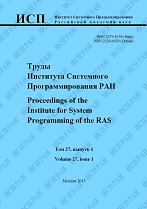|
This article is cited in 2 scientific papers (total in 2 papers)
On the estimations of efficiency and error of fast algorithm in vortex element method
K. S. Kuzmina, I. K. Marchevsky
Bauman Moscow State Technical University, 105005, Russia, Moscow, 2-nd Baumanskaya st., 5
Abstract:
The main computational complexity of vortex methods is concentrated in the calculation of the convective and diffusive velocities of all vortex elements. The analogue of the Barnes–Hut algorithm is considered as one of the most efficient ways to acceleration of the velocities computation in vortex element method. This method is based on the tree (hierarchical structure of regions) construction. When calculating the convective velocities this algorithm makes it possible to take into account the influence of vortex elements, which are located far enough from each other, approximately by using Taylor approximation of expression for convective velocity. The influence of vortex elements, which are close to each other is calculated directly using Biot–Savart law. There are two parameters of algorithm that affect the computational complexity of the algorithm and the problem solving accuracy: $k$ is the maximum tree level, $\theta$ is the parameter, which determines the radius of a near-field zone. When calculating diffusive velocities the influence of the vortex elements to each other decays exponentially with increasing distance between them. Therefore, constructed algorithm of diffusive velocities calculation allows finding vortex elements from near-field zone using tree structure and calculating diffusive velocities using only vortex elements from this zone.
The estimations of computational complexity, which depends on algorithm parameters and number of vortex elements, are obtained for the algorithms for convective and diffusive velocities calculation. Also estimations for the errors of the vortex elements velocities computation, which depend on the algorithm parameters, are constructed. These estimates allow in practice to choice the optimal parameters of the whole algorithm and achieve the maximum possible acceleration of the computations for the given maximum error level.
Keywords:
Vortex element method, Biot–Savart law, viscous flow, diffusive velocity, Barnes–Hut algorithm, fast multipole method, computational complexity, error estimation.
Citation:
K. S. Kuzmina, I. K. Marchevsky, “On the estimations of efficiency and error of fast algorithm in vortex element method”, Proceedings of ISP RAS, 28:1 (2016), 259–274
Linking options:
https://www.mathnet.ru/eng/tisp15 https://www.mathnet.ru/eng/tisp/v28/i1/p259
|

| Statistics & downloads: |
| Abstract page: | 201 | | Full-text PDF : | 102 | | References: | 36 |
|




 Contact us:
Contact us: Terms of Use
Terms of Use
 Registration to the website
Registration to the website Logotypes
Logotypes








 Citation in format
Citation in format 
